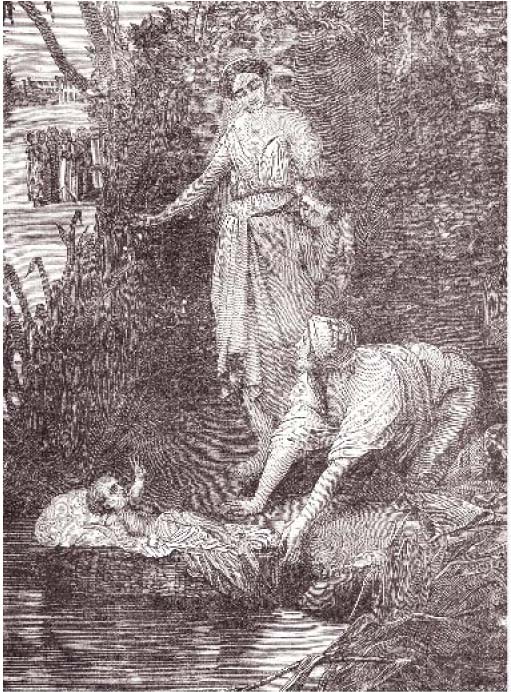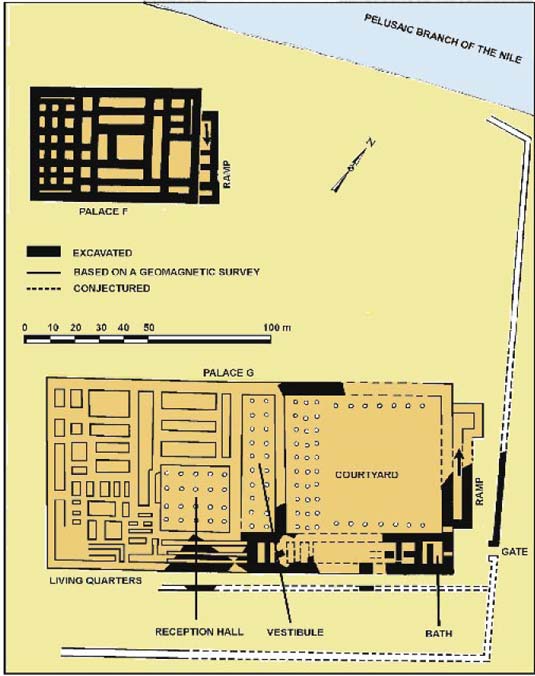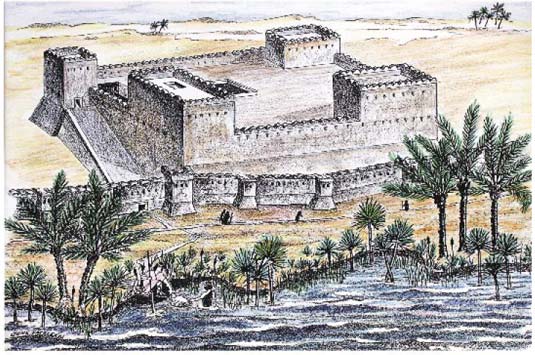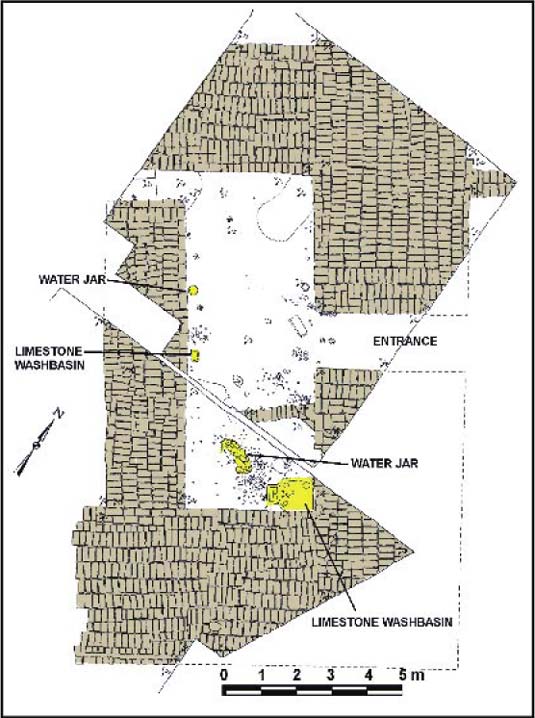This article was first published in the Spring 2004 issue of Bible and Spade.
When Jacob and his family migrated to Egypt, they were settled in “the land of Rameses.” Initially, they were property owners there (Gn 47:11, 27). Soon, however, the Egyptians subjected the Israelites to bondage, using them as slave laborers to build the city of Rameses (Ex 1:11). When Israel left Egypt after 430 years (Ex 12:40), the Bible tells us they departed from Rameses (Ex 12:37). From these references, we can conclude that most Israelites spent the years of the Sojourn in and around Rameses.
Although the location of Rameses was in dispute for some years, that dispute has now been settled. Not only do we know where Rameses is located, but also we know much about the history and culture of the ancient site thanks to archaeological investigation. Extensive excavations have been carried out under the direction of Manfred Bietak of the Austrian Archaeological Institute, Cairo, since 1966.
The mention of Rameses in Exodus 1:11 has been used as an argument for dating the Exodus to the reign of Rameses II (ca. 1279–1212 BC; Egyptian dates in this article are from Wente and Van Siclen 1977: 218), rather than the earlier date of ca. 1450 B.C. derived from the Bible (1 Kgs 6:1; Jgs 11:26; 1 Chr 6:33–37). First, it is argued, if the Israelites were used as slave labor to build the city of Rameses, they must have still been in Egypt during the reign of Rameses II, who built a capital city in the eastern Delta and named it after himself (Hoffmeier 1997: 125; Shea 2003: 237, 248–49). But this interpretation neglects the fact that the Biblical editors often updated archaic place names with later, more familiar, names (Jack 1925: 24–28; Shea 2003: 248–49; Wood 2003: 258, n. 8).
Secondly, many scholars have assumed, based on surviving Egyptian texts, that there was no royal capital in the Delta prior to the city built in the 13th century BC by Rameses II. Thus, Moses could not have confronted a Pharaoh in the Delta prior to the reign of Rameses II (LaSor 1988: 43; Kitchen 2003: 310). However, an argument based on what has not been found from antiquity is always questionable. The number of surviving texts from ancient Egypt is meager, at best. Therefore one cannot base an argument on something not being mentioned in the texts. Furthermore, this assumption has now been proven wrong by recent discoveries.
History of Tell el-Dab‘a
Ancient Rameses is located at Tell el-Dab‘a in the eastern Nile Delta, approximately 100 km (62 mi) northeast of Cairo (Bietak 1986: 278–83; Van Seters 2001: 264–67). In antiquity, the Pelusiac branch of the Nile flowed past the site, giving access to the Mediterranean. In addition, the town was the starting point for the land route to Canaan, the famous Horus Road. Thus, it was an important commercial and military center (Holladay 1997: 190).
The history of the site can be divided into three periods: pre-Hyksos, Hyksos and post-Hyksos. The Hyksos, an Egyptian name meaning “foreign rulers,” were Canaanites who took up residence in the eastern Nile Delta and eventually ruled northern Egypt for some 108 years, ca. 1663–1555 BC (15th Dynasty; Redford 1992). Jacob and his family arrived in Egypt around 1880 BC, based on an Exodus date of ca. 1450 BC. That was in the pre-Hyksos period when the name of the town was Rowaty, “the door of the two roads” (Bietak 1996: 9, 19).
In the 14th Dynasty, toward the end of the 18th century BC, the name was changed to Avaris, “the (royal) foundation of the district” (Bietak 1996: 40). When the Hyksos later established their capital there (Bietak 1997), they retained the name Avaris. It was probably the Hyksos rulers who forced the Israelites to build the store cities of Pithom and Rameses (Ex 1:8–12; Wood 2003: 257–60). When the Egyptians drove the Hyksos leaders out of Avaris in the mid-16th century BC, they undoubtedly changed the name again, possibly to Peru-nefer, which means “happy journey” (Bietak 1996: 82). If that was indeed the new name, then the Israelites left from a place called “happy journey”! When Rameses II built a new city in the 13th century BC in the post-Hyksos period, and long after the Israelites had left Egypt, the name was changed to Rameses (Pusch 2001).

“Then Pharaoh’s daughter went down to the Nile, and her attendants were walking along the river bank. She saw the basket among the reeds and sent her slave girl to get it. She opened it and saw the baby [Moses]. He was crying, and she felt sorry for him. ‘This is one of the Hebrew babies,’ she said” (Ex 2:5–6). Based on Biblical references, there was a royal residence at Rameses that was located close to the Nile. Rameses has been identified as Tell el-Dab‘a in the eastern Nile delta and recent excavations have uncovered a royal residence close to the river dating to the time of Moses. Credit: The “Peerless” Edition of the Holy Bible, Erie PA: Lovell Manufacturing, 188.
Moses and the Rulers of Egypt
In order to avoid the death decree, Moses’ mother placed the infant Moses in a watertight basket and “put it among the reeds along the bank of the Nile” (Ex 2:3). Pharaoh’s daughter discovered the three-month-old baby when she “went down to the Nile to bathe” (Ex 2:5). It is possible that this was the later-to-be-famous-queen Hatshepsut (see front cover Spring 2004 Bible and Spade; Hansen 2003). According to the Bible, then, the Egyptian royal family maintained a residence in Rameses, close to the Nile River, at the time of Moses’ birth in the early 18th Dynasty.
After Moses was nursed by his mother (Ex 2:7–9), Pharaoh’s daughter took him into the royal palace and gave him the name Moses, “because I drew him out of the water” (Ex 2:10). Moses was adopted by Pharaoh’s daughter and raised and educated in the Egyptian court (Acts 7:21–22).

“Pharaoh’s daughter took him and brought him up as her own son. Moses was educated in all the wisdom of the Egyptians and was powerful in speech and action” (Acts 7:21–22). Like the training Daniel and the three Hebrew children received in Babylon (Dn 1), it was a regular New Kingdom practice to raise Asiatic children in the royal court. Educated in the Egyptian language, culture and viewpoint, they would be returned to their homelands to represent Egyptian interests there. The newly discovered royal residence at Rameses was where the royal entourage lived when it was necessary for Pharaoh to be present in the eastern delta, such as when he was making preparations for a northern campaign. As part of the royal family, Moses undoubtedly spent much time in the Rameses palace during the first 40 years of his life. Credit: The “Peerless” Edition of the Holy Bible, Erie PA: Lovell Manufacturing, 188.
Moses remained part of the royal family until age 40, when he fled into exile for murdering an Egyptian overseer who had been mistreating a Hebrew slave (Ex 2:11–12; Acts 7:23–24). After 40 years in Midian (Ex 2:13–4:17; Acts 7:25–34), Moses returned to Rameses. The Bible makes it clear that there was still a royal residence there, as Moses and Aaron were able to have face-to-face confrontations with Pharaoh. Pharaoh’s palace is mentioned frequently and its proximity to the Nile is intimated since Moses and Aaron met Pharaoh several times as he went to the river in the morning.
Moses and his brother Aaron, his spokesman (Ex 4:10–16), “went to Pharaoh,” undoubtedly in the royal palace so familiar to Moses, with the message, “This is what the Lord, the God of Israel says: ‘Let my people go, so that they may hold a festival to me in the desert’” (Ex 5:1). Pharaoh’s answer was, “Who is the Lord, that I should obey him and let Israel go? I do not know the Lord and I will not let Israel go” (Ex 5:2). Pharaoh then made the oppression worse by requiring the Hebrews to gather their own straw for the bricks they were making for royal construction projects. The Israelite foremen futilely appealed to Pharaoh (Ex 5:15–21). Again, this would have taken place in the royal palace.
Moses and Aaron confronted Pharaoh in his palace ten additional times (Ex 7:10; 8:1, 8–11; 9:1–5, 27; 10:3–6, 8, 16–17; 10:24–11:8; 12:30–32) and the palace is mentioned as having been affected by the plagues of frogs and gnats (Ex 8:3, 24).

“So Moses and Aaron went to Pharaoh and did just as the Lord commanded. Aaron threw his staff down in front of Pharaoh and all his officials, and it became a snake. Pharaoh then summoned wise men and sorcerers, and the Egyptian magicians also did the same things by their secret arts: Each one threw down his staff and it became a snake. But Aaron’s staff swallowed up their staffs” (Ex 7:10). After 40 years in exile, Moses returned with Aaron to confront Pharaoh 11 times in his royal palace. They also approached Pharaoh on three other occasions as he went to the Nile early in the morning. These passages indicate that Pharaoh had a residence at Rameses near the Nile River. This fits perfectly with the royal citadel recently discovered at Rameses adjacent to the Pelusiac branch of the Nile. Credit: The “Peerless” Edition of the Holy Bible, Erie PA: Lovell Manufacturing, 188.
Moses and Aaron approached Pharaoh on three occasions when he went to the Nile early in the morning (Ex 7:15–22; 8:20; 9:13–19), suggesting the royal palace was in close proximity to the Nile.
Excavating the Royal Palace of Moses’ Day
In the 1990s an enormous royal citadel occupying some 10 acres was found at Tell el-Dab‘a by Manfred Bietak (Bietak 1996: 67–83; 1997: 115–24; 2001: 353; Bietak, Dorner and Jánosi 2001: 36–101; Dorner 2000: 12–13). The compound was located just south of where the Pelusiac branch of the Nile once flowed in antiquity, bearing out the Biblical depiction of the royal palace being in close proximity to the Nile. It consisted of two palaces and other building complexes that were in use during the time Moses was in Egypt in the early 18th Dynasty. Moses quite likely played among these buildings as a child and walked the halls of the palaces as an adult, then later, after returning from exile, confronted Pharaoh with God’s message, “Let My people go!” (Ex 5:1). It was probably here that Pharaoh mobilized 600 chariots to pursue the Israelites (Ex 14:7).

Royal citadel of Moses’ time at Rameses. Located just south of where the Nile’s Pelusiac branch once flowed in antiquity is this walled in area of ca. 10 acres. Archaeologists found a complex of buildings made of mud brick, including two major palaces, workshops, military areas, storage and cultic facilities. Moses no doubt spent a great deal of time here, being “educated in all the wisdom of the Egyptians” (Acts 7:22). (Based on Bietak, Dorner and Jánosi 2001: figs 4, 33 and 34b.) Credit: Bryant G. Wood.
The northwestern palace, Palace F, originally built in the late Hyksos period, was constructed on a 70 x 47 m (230 x 150 ft) platform approximately 30 m (100 ft) from the riverbank. A ramp on the east side gave access to the palace. It was most likely a monumental watchtower (Bietak 1996: 68). From the top of the building there would have been a clear view of the river and the citadel. The structure probably also served as a palace (Bietak 1996: 70). To the northeast of Palace F was a middle class settlement, including workshops. A series of royal scarabs were found here, covering the period of the early 18th Dynasty from its founder, Ahmosis (ca. 1570–1546 BC), to Amenhotep II (ca. 1453–1419 BC) (Bietak 1996: 72; Bietak, Dorner and Jánosi 2001: 37). Southwest of Palace F were storage rooms and possibly part of a ritual complex (Bietak, Dorner and Jánosi 2001: 36).

Reconstruction of Palace F at Rameses. The smaller of the two palaces found at the royal citadel at Rameses, this structure most likely functioned as a monumental watchtower, as well as a royal palace. Located on the banks of the Nile, the royal citadel excavated by Manfred Bietak matches the Biblical description of Pharaoh’s daughter going “down to the Nile to bathe” (Ex 2:5) and Moses and Aaron confronting Pharaoh “in the morning as he goes out to the water” (Ex 7:15; cf. 8:20). (Based on Bietak 1996: fig 58.) Credit: Gene Fackler.
The main palace, Palace G, was located 78 m (255 ft) southeast of Palace F, with an open courtyard between the two. Palace G occupied an area 79 x 165.5 m (259 x 543 ft), or 3 ¼ acres. To the immediate southwest were workshops and further to the southwest were city-like buildings (Bietak, Dorner and Jánosi 2001: 36–101; Dorner 2000: 85, 36). Palace G was built on a platform 7 m (23 ft) high with entry via a ramp on the northeast side. Since only the substructure remains, the layout of the palace is an estimation based on the layout of the substructure.
The entrance led into a large open courtyard 47 m (150 ft) square with columns on three sides. Proceeding to the southwest, one passed through three rows of columns into a vestibule that had two rows of columns. This marked the beginning of the palace proper, which probably had one or more stories above. The vestibule led into a hypostyle hall to the northwest and a reception hall with four rows of columns to the southeast. It was undoubtedly here in this reception hall where Moses and Aaron met with Pharaoh. Beyond these rooms were the private apartments of the royal family. These would have included private reception rooms, banquet rooms, dressing rooms, bathrooms and sleeping rooms (Bietak, Dorner and Jánosi 2001: 36–101; Dorner 2000: 75, 78–79).

Excavating the foundations of Palace F, 1992. The 3 m (10 ft) wide interior foundation walls of the palace-fort would have supported a massive super structure. In the background are modern mud brick buildings of the village of ‘Ezbet Helmi. Credit: Oral Collins.
The most interesting room found by the archaeologists was a bathing room at the eastern corner of the ground floor of Palace G. It was strategically located opposite a gate in the perimeter wall and at the base of the entrance ramp. Inside the room were washbasins, water jars, foot bowls and ladles. The excavators speculate that visitors would first have to wash in this room before being allowed access to the palace (Bietak, Dorner and Jánosi 2001: 79). When Joseph was taken out of prison to interpret Pharaoh’s dreams, he first had to shave and change his clothes (Gn 41:14). It is possible that Moses and Aaron bathed in this very room before entering the palace to speak with Pharaoh.
The discoveries at Tell el-Dab‘a strikingly corroborate the accuracy of the Exodus account and provide the background and setting for those momentous events.

Plan of the first room of the bath in Palace G. The entrance to this room was across from the gate in the perimeter wall surrounding the royal citadel and at the base of the palace entry ramp. From the utensils found in the room it was clear that it was utilized for bathing. Probably guests were required to make a stop here prior to entering the palace. That being the case, Moses and Aaron would have made use of this room during their frequent trips to the palace at the time of the Exodus. (Based on Bietak, Dorner and Jánosi 2001: fig. 37.) Credit: Bryant G. Wood.
Bibliography
Bietak, Manfred 1986 Avaris and Piramesse: Archaeological Exploration in the Eastern Nile Delta. London: The British Academy.
Bietak, Manfred 1996 Avaris, the Capital of the Hyksos: Recent Excavations at Tell el-Dab'a. London: British Museum Press.
Bietak, Manfred 1997 The Center of Hyksos Rule: Avaris (Tell el-Dab‘a). Pp. 87–139 in The Hyksos: New Historical and Archaeological Perspectives, ed. Eliezer D. Oren. Philadelphia: The University Museum, University of Pennsylvania.
Bietak, Manfred 2001 Dab‘a, Tell ed-. Pp. 351–54 in The Oxford Encyclopedia of Ancient Egypt, ed. Donald B. Redford. New York: Oxford University Press.
Bietak, Manfred; Dorner, Josef; and Jánosi, Peter 2001 Ausgrabungen in dem Palastbezirk von Avaris. Vorbericht Tell el-Dab‘a/‘Ezbet Helmi 1993–2000. Egypt and the Levant 11: 27–119.
Dorner, Josef 2000 A Late Hyksos Water-Supply System at Ezbet Hilme. Egyptian Archaeology 16: 12–13.
Hansen, David G. 2003 Moses and Hatshepsut. Bible and Spade 16: 14–20.
Hoffmeier, James K. 1997 Israel in Egypt. New York: Oxford University Press.
Holladay, John S., Jr. 1997 The Eastern Nile Delta During the Hyksos and Pre-Hyksos Periods: Toward a Systemic/Socioeconomic Understanding. Pp. 183–252 in The Hyksos: New Historical and Archaeological Perspectives, ed. Eliezer Oren. Philadelphia: The University Museum, University of Pennsylvania.
Jack, James W. 1925 The Date of the Exodus in the Light of External Evidence. Edinburgh: T. & T. Clark.
Kitchen, Kenneth A. 2002 On the Reliability of the Old Testament. Grand Rapids MI: Eerdmans.
LaSor, William S. 1988 Rameses. Pp. 41–44 in The International Standard Bible Encyclopedia 4, ed. Geoffrey W. Bromiley. Grand Rapids MI: Eerdmans.
Pusch, Edgar B. 2001 Piramesse. Pp. 48–50 in Oxford Encyclopedia of Ancient Egypt 3, ed. Donald B. Redford. New York: Oxford University Press.
Redford, Donald B. 1992 Hyksos: History. Pp. 341-44 in The Anchor Bible Dictionary, vol. 3, ed. D.N. Freedman. New York: Doubleday.
Shea, William H. 2003 The Date of the Exodus. Pp. 236–55 in Giving the Sense, eds. David M. Howard, Jr., and Michael A. Grisanti. Grand Rapids MI: Kregel.
Van Seters, John 2001 The Geography of the Exodus. Pp. 255–76 in The Land that I will Show You: Essays on the History and Archaeology of the Ancient Near East in Honour of J. Maxwell Miller, eds.David J. A. Clines and Philip R. Davies. Sheffield, England: Sheffield Academic Press.
Wente, Edward F., and Van Siclen III, Charles C. 1977 A Chronology of the New Kingdom. Pp. 217–61 in Studies in honor of George Hughes, January 2, 1977, eds. Janet H. Johnson and Edward F. Went. Chicago: The Oriental Institute of the University of Chicago.
Wood, Bryant G. 2003 From Ramesses to Shiloh: Archaeological Discoveries Bearing on the Exodus–Judges Period. Pp. 256–82 in Giving the Sense: Understanding and Using Old Testament Historical Texts, eds. David M. Howard, Jr., and Michael A. Grisanti. Grand Rapids MI: Kregel.











